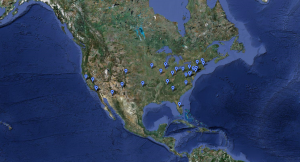Paul Miller – Final Project
![]()
Blurb: “The Babblefish Aquarium” is a virtual aquarium where users can call in and leave a message, and a fish is generated from the pitches of their voice. Try it at babble.zapto.org.
As I explain in the video:
“Please Leave a Fish at the Beep” or “The Babblefish Aquarium” is a website at babble.zapto.org where users can call a phone number and record a message and a virtual fish is created from the pitches of their voice. The fish appear in the aquarium along with the first few digits of the caller’s phone number.
Pitch detection on the recordings is done in Pure Data, with higher pitches making fatter sections of the fish’s body, and lower pitches making narrower sections. Learned: Pure Data’s “fiddle” pitch detection object works great at 44.1 khz with a nice mic, but not so well with an 8 khz cell phone recording. In my patch, I’m doing a band-pass to filter out high and low noise, and then further rejecting detected pitches which fall outside an expected human vocal range.
The backend is Twilio communicating with my web server written in Java (using the ridiculously convenient HttpServer object) which communicates with Pure Data via OSC. My server keeps a list a phone numbers and detected pitches, which the graphical web client (JavaScript & HTML5) periodically requests to generate and animate the fish.
Also learned: the strokeText JavaScript function is hella slow in Safari (not other browsers though). Use fillText for decent FPS.
The reception at the final show was encouraging. Here’s a map of some of the area codes I got:

It would have been sweet if I could automatically take the area codes and produce a .kml for viewing on Google Earth, but I didn’t find an efficient area-code-to-latitude-and-longitude solution, so the above map was annoyingly made by hand.
The recordings I got were very entertaining. Most were either funny vocal noises or speech regarding the fish or the project like “I’m making a fish!” or “Make me a BIG, FAT, FISH.” I got a few songs, some whistles, a number of confused callers (“Hello? Is anybody there?”) and one wrong number who apparently thought they had reached an actual answering machine and left a message regarding someone’s thesis project.
Things to have done, given more time: The graphics are crap. It could do with a pretty aquarium background image, some seaweed or something for the fish to swim between, some animated bubbles… The fish also could have more interesting behavior than swimming in straight lines and staring awkwardly at each other. Flocking would help.
The pitch detection is somewhat crap, though it’s hard to fix that given my reliance on Pure Data and the audio quality of the cell phones. This caused the correspondence between sound and fish shape to be rather weak. Combined with the delay between leaving the message and the fish appearing on the screen resulted in poor user feedback. Participants didn’t feel control over the shapes and therefore (generally) didn’t try to express themselves by making certain kinds of fish. However, the delay did add an element of suspense, which participants seemed to find very exciting.
A solution would be to ditch the cell phones (as I initially intended to do, before my classmates urged me not to) and just have a single reasonable-quality microphone mounted in front of the computer at the show. This would facilitate better pitch detection and remove the time delay, but also remove the mystery and technological prestidigitation of the phone-based interaction.
In all, I’m most excited about the recordings I got. Some of them are very funny, and I hope to find use for them (anonymously, of course) in future projects. Hopefully, the Internet discovers my project and leaves me more interesting sounds.